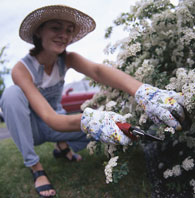2009-10-5
This is the VOA Special English Agriculture Report.
Pruning makes no sense. You cut off parts of a plant. Yet the plant is supposed to grow back even better than before? This demands an answer.
The explanation begins with the apical bud. This bud is at the end of the actively growing tip of the plant.
 |
This causes buds to the side, called lateral buds, to wake up and start growing. The result: better plant development.
Pruning can also remove unhealthy or unneeded parts of a plant, and increase the growth of flowers and fruit.
Generally, the best time to prune is in late winter, before spring growth starts. But gardening experts at the University of Florida extension point out some exceptions.
For example, spring-blooming plants like spireas and azaleas should be pruned after they bloom. Then pinch the new shoots between your thumb and forefinger. That will help them develop branches that produce new blooms.
Plant expert Doug Welsh says when you prune a rosebush, crape myrtle or shade tree, first remove dead, broken or diseased parts. Cut at the place where the problem begins. "Deadhead," or take off, dead blooms.
Remove any branches that touch another branch; leave the stronger one or the one that is in a better position. Remove any branches growing in the same space as the branches next to them. Also prune branches growing toward the ground, high branches growing straight up and shoots growing from the base of the tree.
But Doug Welsh, a professor at Texas A&M University, says not to go too far with pruning. He says a lot of it can be avoided just by choosing the right plant for the right space. "People can ruin what nature has created," he says.
Melissa Snyder, a master gardener in Manatee County, Florida, says pruning wounds a plant. People do not need to put anything on the wound, she says. But they do need to be careful not to wound themselves with chainsaws or other pruning tools.
Also, tools can spread disease from one plant to another. So be sure to disinfect tools with alcohol or bleach after each plant.
And that's the VOA Special English Agriculture Report, written by Jerilyn Watson. Next week, learn about new scientific understanding of how pruning works. And for more gardening advice, go to 51voa.com. I'm Steve Ember.